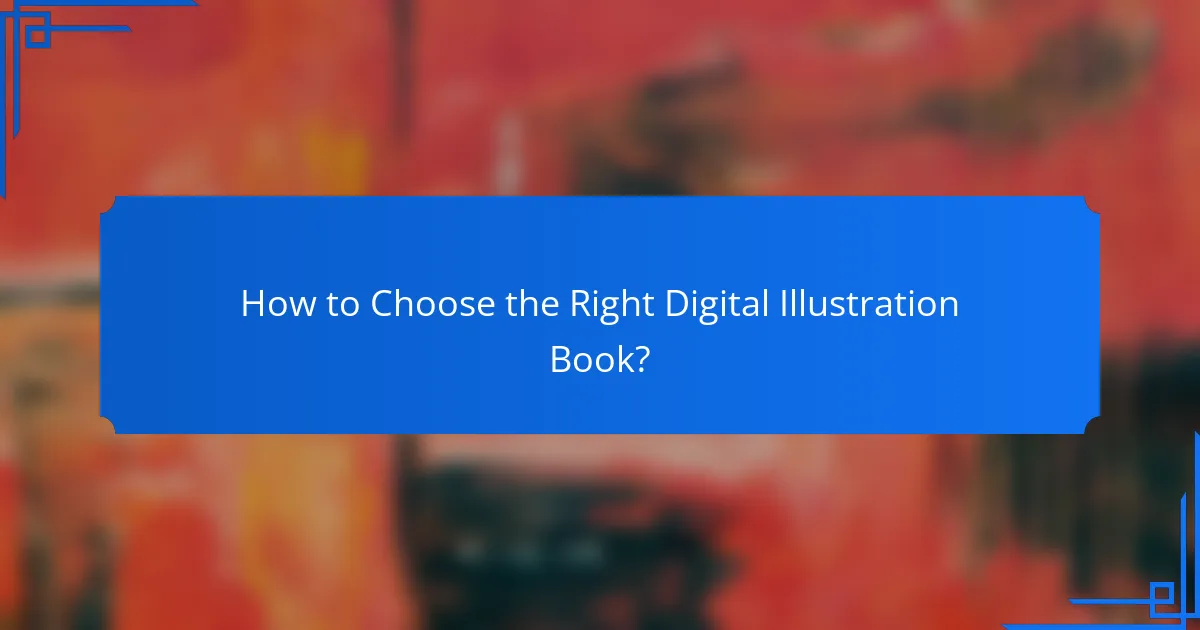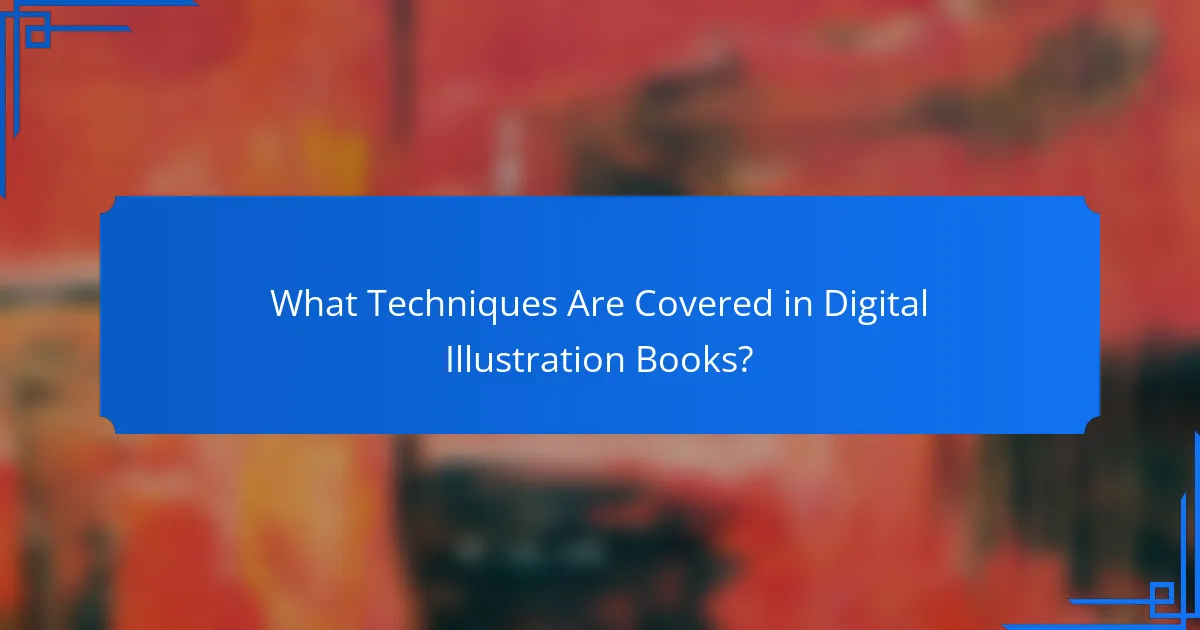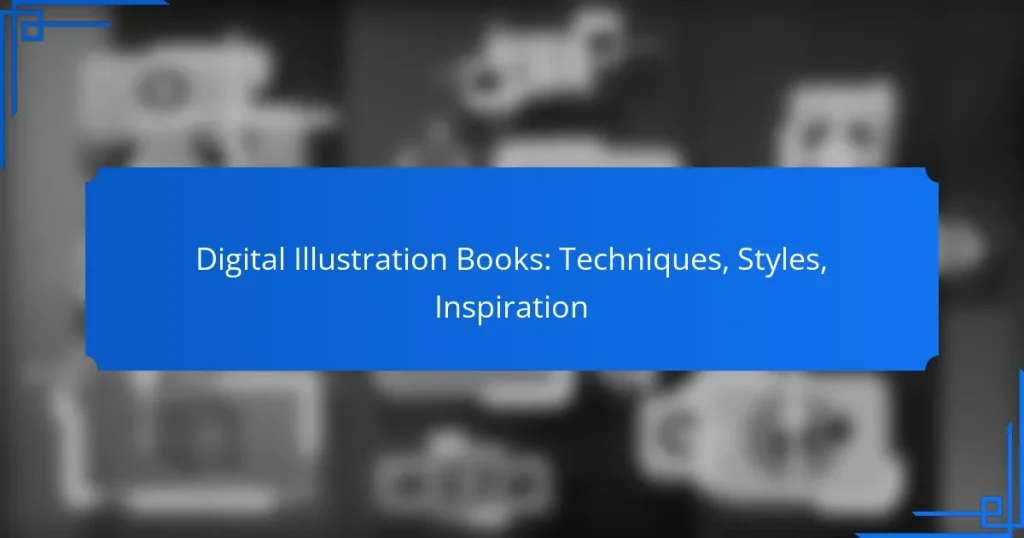Digital illustration books serve as invaluable resources for both beginners and experienced artists, offering essential techniques, styles, and inspiration to elevate their craft. By exploring various artistic methods and practical exercises, these books help artists enhance their creativity and technical skills, making them a vital part of any illustrator’s library.

What Are the Best Digital Illustration Books for Beginners?
The best digital illustration books for beginners provide foundational skills, techniques, and inspiration to help new artists develop their craft. These resources cover essential software, artistic styles, and practical tips to enhance creativity and technical abilities.
“Digital Painting Techniques” by 3DTotal Publishing
This book is a comprehensive guide that introduces beginners to various digital painting techniques. It features step-by-step tutorials from professional artists, showcasing different styles and methods that can be applied in software like Photoshop and Corel Painter.
Readers can expect to learn about color theory, brush techniques, and composition. The book also emphasizes the importance of practice and experimentation, encouraging artists to develop their unique style through hands-on projects.
“The Digital Artist’s Handbook” by David Hockney
David Hockney’s “The Digital Artist’s Handbook” serves as an insightful resource for beginners looking to explore digital art. This book combines artistic philosophy with practical advice, making it suitable for those interested in both the technical and conceptual aspects of digital illustration.
It covers various digital tools and techniques, along with exercises designed to spark creativity. Hockney’s unique perspective on art encourages readers to think outside the box and embrace the digital medium as a legitimate form of artistic expression.
“Adobe Illustrator for Beginners” by John Smith
“Adobe Illustrator for Beginners” is an essential resource for anyone wanting to master vector illustration. This book breaks down the software’s interface and tools, providing clear instructions on creating graphics, logos, and illustrations from scratch.
Smith includes practical exercises that guide readers through the process of designing with Illustrator, focusing on key features like the pen tool, layers, and color management. Beginners will benefit from tips on avoiding common pitfalls and maximizing efficiency in their workflow.

How to Choose the Right Digital Illustration Book?
Choosing the right digital illustration book involves considering your current skills, preferred styles, and the inclusion of practical exercises. A well-selected book can enhance your abilities and inspire creativity.
Consider your skill level
Your skill level is crucial when selecting a digital illustration book. Beginners should look for books that start with foundational techniques and concepts, while intermediate and advanced artists might prefer more specialized topics or complex styles.
Evaluate the book’s content to ensure it matches your expertise. For instance, a beginner might benefit from a book that covers basic software tools, while an advanced artist may want one that delves into advanced techniques like digital painting or 3D modeling.
Identify your preferred style
Understanding your preferred illustration style can significantly influence your choice. Whether you are drawn to realism, cartooning, or abstract art, selecting a book that aligns with your interests will keep you engaged and motivated.
Look for books that showcase a variety of styles and techniques. Many books include sections on different genres, allowing you to explore and refine your artistic voice while learning new skills.
Check for practical exercises
Practical exercises are essential for applying what you learn from a digital illustration book. Books that include step-by-step projects or assignments help reinforce concepts and techniques.
Seek out books that offer a mix of theory and hands-on practice. A good rule of thumb is to choose a book with at least one exercise per chapter, ensuring you can actively engage with the material and track your progress.

What Techniques Are Covered in Digital Illustration Books?
Digital illustration books typically cover a variety of techniques that enhance the artist’s ability to create compelling visuals. Key techniques include layering and blending, brush techniques, and color theory applications, each offering unique methods to improve artwork quality and depth.
Layering and blending
Layering and blending are fundamental techniques in digital illustration that allow artists to build complex images by stacking multiple layers. Each layer can contain different elements, such as background, midground, and foreground, enabling greater control over the composition.
Blending modes play a crucial role in how layers interact with each other. For instance, using the ‘multiply’ mode can darken colors, while ‘screen’ can lighten them. Experimenting with these modes can yield interesting effects and enhance the overall aesthetic of the artwork.
Brush techniques
Brush techniques are essential for creating texture and detail in digital illustrations. Artists can choose from a variety of brush types, such as soft, hard, textured, or custom brushes, each offering different effects. Understanding how to manipulate brush settings, like opacity and flow, can significantly impact the final result.
For effective use, consider practicing with different brushes to see how they interact with various colors and layers. A good tip is to create a brush library tailored to your style, allowing for quick access to your favorite tools during the illustration process.
Color theory applications
Color theory applications in digital illustration involve understanding how colors interact and influence the viewer’s perception. Key concepts include complementary colors, analogous colors, and the color wheel, which can guide artists in creating harmonious palettes.
When applying color theory, consider using a limited color palette to maintain cohesion in your artwork. A common approach is to select three main colors and their shades, which can help in achieving balance and visual interest without overwhelming the viewer.

Which Styles Are Popular in Digital Illustration?
Popular styles in digital illustration include concept art, character design, and vector art. Each style has unique characteristics and applications, catering to different artistic needs and preferences.
Concept art
Concept art is primarily used in the pre-production phase of films, video games, and animations. It focuses on visualizing ideas and establishing the overall aesthetic of a project, often depicting environments, characters, and objects.
Artists typically create multiple iterations of a design to explore various possibilities. Tools like Adobe Photoshop or Procreate are commonly used, allowing for quick adjustments and experimentation.
Character design
Character design involves creating the visual appearance and personality of characters for various media. This style emphasizes traits such as shape, color, and clothing to convey a character’s role and emotions effectively.
Designers often start with sketches and refine them into detailed illustrations. It’s crucial to consider the character’s backstory and context, as these elements influence their visual representation.
Vector art
Vector art is created using mathematical equations to define shapes, making it scalable without loss of quality. This style is popular for illustrations that require clean lines and bold colors, such as logos and infographics.
Software like Adobe Illustrator is commonly used for vector illustrations. Artists should focus on simplicity and clarity, as vector art often relies on geometric shapes and flat color palettes.

Where to Find Inspiration for Digital Illustration?
Inspiration for digital illustration can be found in various online spaces that showcase creativity and artistic expression. Exploring these platforms can help you discover new techniques, styles, and ideas that resonate with your artistic vision.
Online platforms like Behance
Behance is a leading platform where artists display their portfolios, making it an excellent source for inspiration. You can browse through a vast array of projects across different styles and mediums, allowing you to see what’s trending in the digital illustration world.
When using Behance, consider following artists whose work you admire and engaging with their projects through comments or likes. This interaction can lead to a deeper understanding of their techniques and creative processes.
Art communities on Instagram
Instagram hosts numerous art communities that share digital illustrations, making it a vibrant source of inspiration. By following relevant hashtags like #DigitalArt or #Illustration, you can discover a diverse range of styles and techniques from artists around the globe.
Engaging with these communities can also provide opportunities for collaboration and feedback. Consider participating in discussions or sharing your own work to connect with other artists and gain insights into their creative journeys.
Art challenges and contests
Participating in art challenges and contests can spark creativity and push your artistic boundaries. These events often have specific themes or prompts that encourage you to think outside the box and experiment with new styles.
Look for challenges on platforms like DeviantArt or social media, where you can join fellow artists in creating work based on a shared theme. This can not only inspire you but also help build your portfolio and connect with a broader audience.

What Are the Key Trends in Digital Illustration?
Key trends in digital illustration include the integration of augmented reality and the use of 3D techniques. These advancements enhance visual storytelling and create immersive experiences for audiences.
Augmented reality integration
Augmented reality (AR) integration in digital illustration allows artists to create interactive experiences that blend the digital and physical worlds. By using AR tools, illustrators can overlay digital images onto real-world environments, enhancing engagement and storytelling.
To implement AR, artists can use platforms like Adobe Aero or Unity, which provide user-friendly interfaces for creating AR content. Consider focusing on user experience; ensure that the AR elements are intuitive and add value to the illustration rather than distract from it.
3D illustration techniques
3D illustration techniques involve creating three-dimensional visuals that can be manipulated and viewed from various angles. This approach adds depth and realism to illustrations, making them more captivating and lifelike.
Popular software for 3D illustration includes Blender and Cinema 4D, which offer a range of tools for modeling, texturing, and rendering. When using 3D techniques, keep in mind the balance between detail and performance; overly complex models can slow down rendering times and may not be suitable for all applications.


